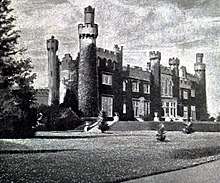Thomas Luttrell (Irish judge)
Sir Thomas Luttrell (born before 1490 – died 1554 ) was a wealthy Anglo-Irish landowner of the sixteenth-century Irish Pale. He was also a distinguished lawyer and judge who held the offices of Solicitor General for Ireland and Chief Justice of the Irish Common Pleas.
Background

He was born in Dublin, the eldest son of Richard Luttrell of Luttrellstown Castle, the head of a prominent Anglo-Irish family, which came originally from Lincolnshire, and his wife Margaret FitzLyons. His exact date of birth is not recorded but it was almost certainly before 1490, since his first marriage took place in 1506.[1]
Little is known of his early years. He was involved in litigation over a disputed inheritance in 1527. He was presumably by then a barrister of some years standing, since he became King's Serjeant and Solicitor General in 1532. He was spoken of as a possible judge of the Court of Common Pleas (Ireland) in 1533, and in the next year became Chief Justice of that Court, holding that office until his death 20 years later.[2]
In government
He was an active member of the Privy Council of Ireland. He accompanied Sir William Skeffington, the Lord Deputy of Ireland on a mission to negotiate with the O'Toole clan. Luttrell was of great assistance on this mission since (perhaps surprisingly, given his attitude to Gaelic culture) he spoke fluent Irish.[3] He took charge of the defence of Dublin in the Lord Deputy's absence and was praised for his diligence in that regard. He sat on a commission into the acquisition by the Crown of monastic lands in 1541, and himself received several grants, notably of the lands of St. Mary's Abbey at Clonsilla. He was knighted in 1540.
When Henry VIII set up a commission, headed by Sir Anthony St. Leger in 1537, on the governance of Ireland, Luttrell submitted a detailed memorandum on the subject. In this paper he recommended the imposition of the English language and style of dress on the inhabitants of the Pale, the expulsion of Irish musicians from the Pale, and the need to discourage English settlers from returning home. He wrote about the danger of trusting Irish soldiers, the need to subdue the neighbouring Gaelic clans, the desirability of the Lord Deputy being English, and the necessity for the Deputy to serve a lengthy term of office. He argued that the inhabitants of the Pale were overtaxed, and he recommended the printing of the Irish Statutes.[4]
Death and memorial
Luttrell was in London at the time of Mary I's accession[5] but returned to Dublin and died there the following year. He was a wealthy man, due partly to his acquisition of monastic lands: his will refers to numerous objects of gold and silver, and in 1538 he was able to present Thomas Cromwell with a goshawk, which was always a very rare bird in Ireland, and therefore much prized. Though he outwardly conformed to the Church of Ireland, on his deathbed he requested prayers for the salvation of his soul, and was suspected of remaining a Roman Catholic at heart.[6] He was buried by his own direction "with honesty but no pomp" in Clonsilla Church, and left a bequest for the building of a mortuary chapel there. On a more worldly note he directed that open house be kept for guests at Luttrellstown Castle.
Character
Elrington Ball sums up Luttrell as "a typical gentleman of the English Pale of his time". Although his family had been settled in Ireland for centuries; although he had constant contact with the neighbouring Old Irish families from his early youth onwards, and even spoke fluent Irish, he identified wholly with the interests of England. Ireland outside the Pale was to him a foreign country. Probably his most attractive quality was the hospitality for which he was famous.[7]
Family
Luttrell married firstly, and apparently while he was still in his teens, Anne Aylmer, daughter of Bartholomew Aylmer and Margaret Cheevers, and sister of his future colleague Sir Gerald Aylmer. His second wife was Elizabeth Bathe, daughter and co-heiress of Sir William Bathe of Rathfeigh, County Meath. By his two marriages he had at least nine children-
- Richard, who predeceased him
- Anne, who married Thomas Dillon of Riverstown, County Meath, and was the mother of Sir Robert Dillon, Chief Justice of the Irish Common Pleas
- Christopher, who inherited his father's estate but died two years after him, without male heirs
- Margaret, who married Luke Netterville: their descendants held the title Viscount Netterville
- Sir James Luttrell, High Sheriff of County Dublin, who inherited Luttrellstown from his brother Christopher; he was the second husband of the much married Jenet Sarsfield, but they had no surviving issue
- Simon, his brother James's heir, from whom later generations of Luttrells were descended
- Robert
- John
- Walter.
References
- Ball, F. Elrington History of the County Dublin Volume IV Alexander Thom Dublin 1907
- Ball F. Elrington The Judges in Ireland 1221–1921 John Murray London 1926
- Ball History of the County Dublin
- Ball History of the County Dublin
- Ball The Judges in Ireland
- Lennon, Colm Sixteenth-century Ireland- the Incomplete Conquest Gill and Macmillan 1994 p.313
- History of the County Dublin